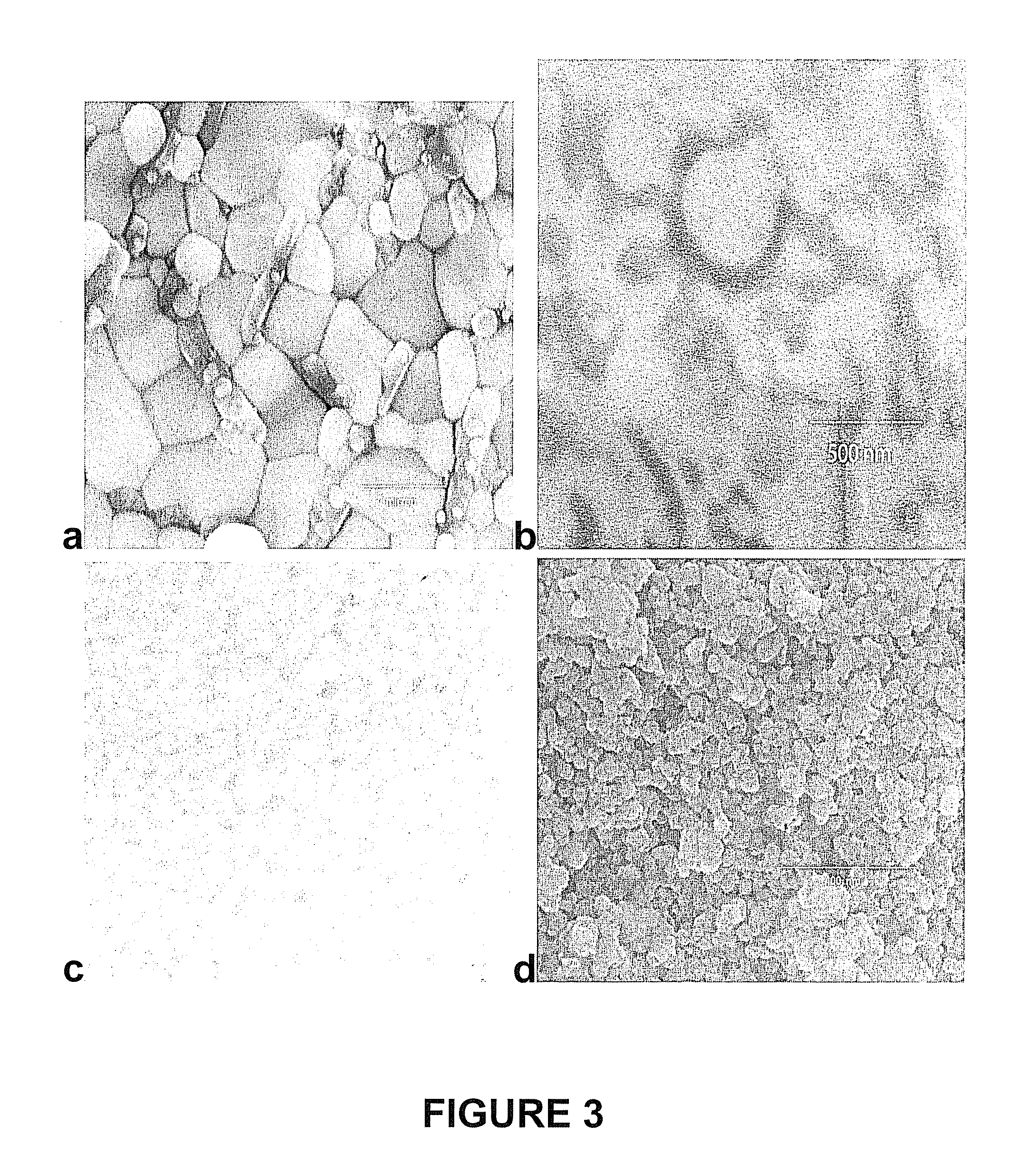Method of pressureless sintering production of densified ceramic composites
a technology of densified ceramics and composites, applied in chemical/physical processes, inorganic chemistry, special surfaces, etc., can solve the problems of difficult processing to full density, difficult to achieve the full density of densities, and the density of hiping can often be significantly less than desired
- Summary
- Abstract
- Description
- Claims
- Application Information
AI Technical Summary
Benefits of technology
Problems solved by technology
Method used
Image
Examples
example 1
[0078]Fully dense (ZrO2)x(Al2O3)1-x ceramic nanocomposites with homogeneous, nanosize grains are formed from LF-FSP produced core-shell nanoparticulate powders, as set forth herein. (ZrO2)1-x(Al2O3)x nanoparticle powders with molar ratios that span the (ZrO2)(Al2O3) composition range are formed. Liquid-feed flame spray pyrolysis (LF-FSP) of mixtures of N(CH2CH2O)3Al (alumatrane) and Zr(CH3CH2COO)2(OH)2 precursors dissolved in ethanol, are aerosolized with O2. The resulting aerosol stream is ignited via methane pilot torches followed by combusting the mixture into quartz chamber about 1.5 m long and combusted at temperatures of about 1500-2000° C. and quenched rapidly thereafter to provide (ZrO2)1-x(Al2O3)x nanopowder soot collected using wire-in-tube electrostatic precipitators (ESP).
[0079]All powders exhibit average particle sizes (APSs) less than about 20 nm and corresponding surface areas of about 50 m2 / g when produced at rates of 100-300 g / h. It is possible to make core-shell na...
example 2
[0082]In these studies, (ZrO2)0.54(Al2O3)0.45 core-shell nanopowders were processed in accordance with Example 1 and mixed with 2 wt. % binder (polyethylene glycol), cold isostactic pressed (CIPed) at about 200 MPa to form green bodies, and heated in air at about 1° C. / min to 800° C. for binder burn out.
[0083]The resulting (ZrO2)0.54(Al2O3)0.45 compact is cut into 12.7 mm discs with avg. 1.4 mm thickness with the diamond saw to form flat, squares with 1.27 mm sides that were placed in the dilatometer. Samples were heated in synthetic air at 5° C. / min to 1425° C. providing the trace shown in FIG. 2.
[0084]Dilatometry is run using a Theta Industries Dilatronic 6500 (Port Washington, N.Y.) with a thermal expansion head under mild compression. Data is collected using LabView program. The flat, square pellets (with an average 1.27 mm on a side) used for the dilatometry runs are sectioned and placed between an alumina block and the alumina push rod. Constant heating rate (CHR) experiments ...
example 3
[0093]After creation of fully dense (ZrO2)0.54(Al2O3)0.45 nanocomposites from core-shell source Zr—Al—O powders, separate source nanopowders of t-zirconia and δ-alumina by LF-FSP are used to produce fully dense nanoparticle composites. The same procedure of green body preparation and sintering is used for these mixed oxides samples as in Example 1 for a comparison between core-shell and mixed oxides source.
[0094]According to the XRD data (FIG. 4), mixed oxides source indicate the monoclinic phase of zirconia. It is presumed that the effect of alumina on the zirconia phase transformation from tetragonal to monoclinic is not valid in this mixed oxides case, as zirconia is already converted to monoclinic below 1120° C. The relative density of this mixed oxides product is about 0.89. Microstructure of mixed oxides source composites (FIG. 7) also indicates that a final product is not a dense nanocomposite.
PUM
| Property | Measurement | Unit |
|---|---|---|
| particle size diameter | aaaaa | aaaaa |
| temperature | aaaaa | aaaaa |
| temperature | aaaaa | aaaaa |
Abstract
Description
Claims
Application Information
 Login to View More
Login to View More - R&D
- Intellectual Property
- Life Sciences
- Materials
- Tech Scout
- Unparalleled Data Quality
- Higher Quality Content
- 60% Fewer Hallucinations
Browse by: Latest US Patents, China's latest patents, Technical Efficacy Thesaurus, Application Domain, Technology Topic, Popular Technical Reports.
© 2025 PatSnap. All rights reserved.Legal|Privacy policy|Modern Slavery Act Transparency Statement|Sitemap|About US| Contact US: help@patsnap.com



